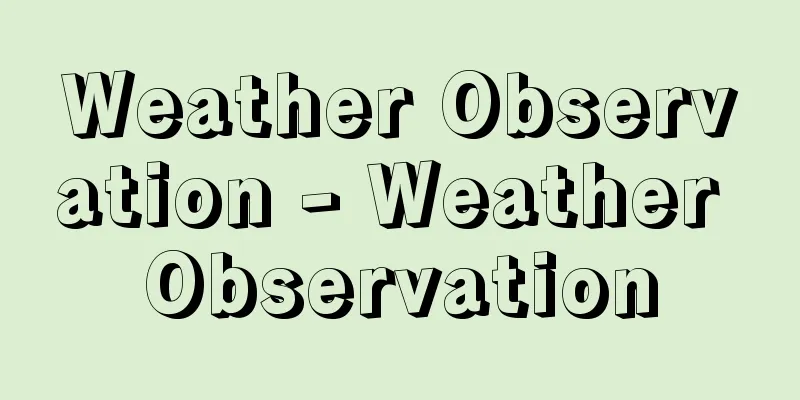Weather Observation - Weather Observation

|
Measuring and observing the physical state of the atmosphere, such as temperature, air pressure, and wind, as well as atmospheric constituents such as water vapor and carbon dioxide, precipitation on the Earth's surface, solar radiation, cloud conditions, and phenomena such as thunderstorms and rainbows. It also includes observations of snow cover and ocean waves. In a broad sense, meteorological observation also includes the processing and analysis of observed data. [Takeji Shinohara and Kiyomitsu Watanabe] historyIt is said that wind direction was observed in Greece in the 6th century BC, and rainfall was observed in India in the 4th century BC. Torricelli's experiment, which led to the invention of the mercury barometer, was conducted in 1643, and meteorological observations using measuring instruments began in the early 19th century. In 1873, the first International Meteorological Congress was held in Vienna, Austria, to address the issue of standardizing observation methods. In 1951, this conference developed into the World Meteorological Organization (WMO), an organization of the United Nations, and is currently promoting the construction and operation of a global meteorological observation network called the World Weather Watch (WWW). In Japan, meteorological observations for the purpose of weather forecasting have been conducted for a long time, but the oldest observation records of atmospheric pressure and temperature by Japanese people were made in 1827 (Bunsei 10). The Tokyo Meteorological Observatory, the predecessor of the Japan Meteorological Agency, began observations in 1875 (Meiji 8). Currently, meteorological observation has become significantly more diverse, beginning with meteorological satellites, and telemetry measurements and computer processing of data are becoming more widespread. [Takeji Shinohara and Kiyomitsu Watanabe] Observation TypeWeather observations can be classified according to purpose, means, observation elements, etc. In addition to the observations described below, observations using special measuring instruments include balloon observations, weather satellites (such as Himawari), weather radar, laser radar, and rocket weather observations. (1) Surface meteorological observation Surface meteorological observation has been conducted for a long time by weather stations and observatories. Its purpose is to be used in many ways, such as to report immediately in order to create weather charts and to compile observation data to study the climate. Most amateur meteorological observations belong to this category. Atmospheric pressure, temperature, humidity, precipitation, wind, and hours of sunshine are measured using instruments, while clouds and weather are observed visually. In addition to the above, the Japan Meteorological Agency has over 1,300 telemeter observation points throughout Japan. These are called regional meteorological observations or AMeDAS. The observation elements are wind direction, wind speed, temperature, hours of sunshine, precipitation, and snow depth, and the data is collected every hour via telephone lines to a computer at a center in Tokyo and distributed to users. Users can also access the telemeters at any time and as needed to obtain the data. The main purpose of this system is to immediately grasp severe meteorological phenomena that occur in a relatively small area, such as torrential rain. (2) Visual observation: This refers to observation in which the results of seeing and hearing meteorological phenomena are recorded. It is also important for observers to be in constant contact with natural phenomena and deepen their understanding. In order to ensure accurate and objective observation results, it is necessary to standardize the definitions and terminology of phenomena. Clouds, rain, snow, etc. are classified using the "Cloud Observation" (a supplement to "Ground Meteorological Observation Methods") published by the Japan Meteorological Agency in 1989, but since March 2000, the "Cloud Guide" edited by the Japan Weather Association has also been used as an introductory guide. The shape, extent, brightness, and color of clouds vary depending on the size and number of cloud particles, whether they are water droplets or ice crystals, and the state of the air currents. First, the cloud shape is characterized and divided into 10 types such as cirrus, cumulus, and stratus, and the detailed characteristics are described by type such as tower clouds and lenticular clouds. In addition, depending on the arrangement of the cloud fragments and the degree of transparency, there are variations such as wavy clouds, radial clouds, and opaque clouds. The 10 types are recorded with alphabetical codes such as Ci (cirrus), Cu (cumulus), and St (stratus). Alphabetical codes called C L , C M , and C H are used to indicate the overall state of the cloud. For example, C L =1 is a clear-weather cumulus cloud that is not very vertically developed, C M =3 is a single layer of altocumulus clouds with a glimpse of blue sky, and C H =7 is a state in which cirrostratus clouds spread across the sky without gaps. Cloud cover is recorded as a tenth of the sky (0-10). Cloud height and movement may also be observed visually. Rain, snow, fog, etc. are collectively called atmospheric phenomena, and are broadly classified into hydrometeor, atmospheric dust phenomena, atmospheric optical phenomena, and atmospheric electrical phenomena. Hydrometeor includes 34 phenomena such as rain, drizzle, snow, snow hail, ice hail, frost snow, hail, fog, mist, and blizzard. There are ten types of dust phenomena, including smoke, yellow sand, and dust devils; nine types of light phenomena, including haloes, iridescent clouds, and rainbows; and three types of electrical phenomena, including thunder, lightning, and thunder. When these phenomena are observed, the start and end times, the state of change, and, depending on the phenomenon, the direction and distance from the observation point are recorded. Although not atmospheric phenomena, observation records of particularly rare phenomena such as auroras and noctilucent clouds are also valuable academically. Snowflake shapes are classified into seven types by the International Hydrological Association, as well as a classification method (1966) by Mago Choji (1916-1985). According to the Japanese Society of Snow and Ice (1967), snow cover is first divided into new snow, firm snow, granular snow, and frost granular snow, and then further subdivided. There have long been various classification methods for expressing weather conditions by grouping together clouds and atmospheric phenomena, but the system that is used internationally is a set of 100 numerical codes. For example, continuous moderate rain is given the code 63. In Japan, 15 types of weather and their corresponding symbols are used. These are based on the symbols used on the first weather map of Japan created by the German Knipping in 1883 (Meiji 16). When observing visibility by sight, you must first determine the target tree, building, etc., and find the distance to it. When observing on a dark night, you must first find the distance and brightness of unfocused electric lights, etc. (3) Long-term climate observation The purpose is to obtain data with good uniformity from locations with minimal environmental changes so as to grasp changes in the climate and avoid the influence of urbanization, etc. (4) Mountain weather observations In order to obtain continuous high-altitude weather data, instruments that are protected against strong winds, snow and ice are used. Observers must endure lonely environments, especially in winter, but they have the opportunity to experience rare weather phenomena, just as they do in polar regions. In Japan, observations are conducted throughout the year at the summit of Mt. Fuji and several other locations, and at many other mountain peaks, such as the Japanese Alps, during the summer climbing season. Observation data from the summit of Mt. Fuji has been published since the summer of 1932 (Showa 7). (5) Marine weather observation: In addition to the additional observation elements that cannot be observed on land, such as sea surface temperature, waves, and sea ice, because the observation is conducted while sailing, and on a ship that is in a state of motion, it is necessary to devise methods for measuring air pressure, wind, precipitation, etc. The buoy robot is a circular buoy attached to a rope that extends from an anchor on the seabed, and a telemetry-based observation device is attached to it, and data is sent to the base via shortwave communication or other means. (6) Aviation weather observations Observations used for takeoffs and landings at airports include regular observations and special observations (specials) conducted whenever weather conditions worsen or improve. Emphasis is placed on observation of cloud base height (ceiling), visibility, runway visual range, wind, and air pressure. Regular passenger aircraft are required to report weather conditions along the route. Weather reconnaissance aircraft are also used to observe typhoons over the ocean. (7) Agricultural meteorological observation Data obtained from ordinary meteorological observations, such as temperature, precipitation, and sunshine hours, are useful for investigating the climatic conditions suitable for agricultural crops, for fertilizer management, and for measures against pests and diseases. For more detailed applications, such as greenhouse management and measures against frost damage, observations must be made on cultivated land, and special factors such as evaporation, solar radiation, and underground temperature are required. (8) Hydrometeorological Observation To prevent and reduce flood damage and to effectively use precipitation as a water resource, it is necessary to know the amount of water in a river basin, such as rain, snow, and evapotranspiration. To estimate the amount of meltwater, the amount of snowfall in mountainous areas is measured. An appropriate number of observation points are placed in and near the basin, and the technology to estimate the average and total amount in the basin from the data is emphasized. (9) Air Pollution Monitoring Meteorological Observation Meteorological data is necessary to regulate air pollutants emitted from factories, automobiles, etc. based on standard values. Wind and temperature measurement points are set up at intervals of several kilometers or even smaller in industrial areas, cities, and their surrounding areas, and data is collected online. In order to investigate the impact of pollution on the air around the world, observation points for monitoring background pollution have been established based on WMO resolutions, and atmospheric turbidity and substances contained in precipitation are measured. (10) Upper air observation Radiosondes and rawins are mainly used to observe air pressure, temperature, and wind at heights of 20 to 30 kilometers. Low-altitude sondes and tethered balloons are used for observations at relatively low altitudes of a few kilometers. Weather observation rockets are used for observations at heights of about 20 to 60 kilometers. [Takeji Shinohara and Kiyomitsu Watanabe] Observation networkWhile observation data from one location may be sufficient for a given purpose, meteorological phenomena are widespread, and so observations from many locations are often required. The arrangement of observation locations is called an observation network. It may also include the number of observations, time, and data transmission method. The observation network is constructed according to the intended use of the data, but this is often not ideal for economic reasons. To know the detailed weather of urban areas and agricultural land, observation points are required to be spaced apart by several kilometers or even several hundred meters. In regional meteorological observation, rainfall observation points are set up at an average interval of about 17 kilometers to capture areas of heavy rain. To use a weather radar observation network to monitor heavy rain, the radar installation points are selected so that they cover areas where radio waves cannot reach due to the shadow of mountains. To draw a weather map of a wide area including the entire surface of the earth, an observation network that captures high and low pressure systems without exception is required. There are about 4,000 observation points on the earth, but they are unevenly distributed on land, and even if observations by ships and buoy robots are added, it is far from ideal. Although reports from commercial aircraft are used along air routes over the ocean to monitor upper air weather, it is extremely insufficient. Observations by meteorological satellites are extremely important to fill in the gaps in such observation networks. [Takeji Shinohara and Kiyomitsu Watanabe] "Guidelines for the Use of Meteorological Instruments" (1971), edited and published by the Japan Meteorological Agency. ▽ "Weather Observation Techniques for Practical Application" by Ota Masatsugu and Shinohara Taketsugu (1985, Chijin Shokan). ▽ "Surface Meteorological Observation Methods" (1988), edited and published by the Japan Meteorological Agency. ▽ "Special Issue of Surface Meteorological Observation Methods: Cloud Observation" (1989). ▽ "Revised New Edition of New Guide to Meteorological Observation" by Mori Shigeo (1990, Japan Weather Association). ▽ "Illustrated Guide to How Weather Works - From Basic Knowledge and Observation of Meteorological Phenomena to Actual Weather Forecasting" by Norimura Yo (1998, Shinsei Publishing). ▽ "Easy-to-Understand Meteorological and Weather Knowledge" by Takatsuka Tetsuhiko (1999, Seitosha). ▽ "Meteorological Information Department of the Japan Weather Association, "Guide to Clouds - Ten Types of Cloud Forms" by Yuyama Iku (2000, Climb Meteorological Book Publishing Division)" [References] | | | | | | | | | | | | |A balloon-based observation of upper atmosphere winds conducted at the Latitude Observatory (now the Mizusawa VLBI Observatory) around 1920 (Taisho 9) ©National Astronomical Observatory of Japan "> Upper-air wind observations in the Taisho period Source: Shogakukan Encyclopedia Nipponica About Encyclopedia Nipponica Information | Legend |
|
気温や気圧や風など大気の物理的な状態、また水蒸気や二酸化炭素のような大気の構成物質、地球表面への降水、または日射、さらに雲の状態、雷雨や虹(にじ)などの現象を測定、観察すること。積雪や海面の波などの観測も含める。観測データの処理、分析も広い意味では気象観測である。 [篠原武次・渡邉清光] 歴史紀元前6世紀にギリシアで風向の観察が行われたといわれ、前4世紀にはインドで雨量の観測がなされた。水銀気圧計の発明へと導かれるトリチェリの実験は1643年のことで、19世紀初めには測定器械による気象観測が行われるようになった。1873年には第1回国際気象会議がオーストリアのウィーンで開催され、観測方法統一の問題を取り上げた。この会議は、1951年には、国際連合の機構の一つであるWMO(World Meteorological Organizationの略、世界気象機関)へと発展し、現在WWW(World Weather Watchの略、世界気象監視)とよばれる全地球をカバーする気象観測網の構成と運用を推進している。日本においては、天気予測を目的にした気象の観察はかなり昔からなされていたが、日本人による気圧や気温のもっとも古い観測記録は1827年(文政10)につくられた。気象庁の前身である東京気象台が観測を開始したのは1875年(明治8)である。現在、気象衛星をはじめとし、気象観測は著しく多様化し、テレメータ方式の測定とデータのコンピュータ処理が普及しつつある。 [篠原武次・渡邉清光] 観測の種類目的、手段、観測要素などに目をつけて気象観測を分類することができる。次に述べる観測のほか、特殊な測定器械を用いる観測としては気球観測、気象衛星(「ひまわり」など)、気象レーダー、レーザー・レーダー、ロケット気象観測などがある。 (1)地上気象観測 気象台や測候所で古くから行われている。天気図をつくるための即時通報と、観測データを集計して気候を調べるなど、多方面への利用が目的である。アマチュアの気象観測も、たいていこれに属する。気圧、気温、湿度、降水量、風、日照時間などは測器を用いて測るが、雲や天気などは目視で観測する。以上のほかに、気象庁は日本全土に1300余りのテレメータの観測点をもっている。地域気象観測あるいはAMeDAS(アメダス)とよばれる。観測要素は風向、風速、気温、日照時間、降水量、積雪深で、毎時間のデータが電話線で東京にあるセンターのコンピュータに集信され、利用者に配信される。また利用者が、いつでも、必要に応じてテレメータを呼び出し、データを得ることができる。このシステムのおもな目的は、集中豪雨など比較的狭い地域に現れる激しい気象現象を、即座に把握することにある。 (2)目視観測 気象現象を目で見たり耳で聞いたりした結果を記録にとどめる観測をいう。観測者が常時自然現象に接して理解を深めるうえでも重視される。正確で客観的な観測成果を期するため、現象の定義や用語などを統一しておく必要がある。 雲や雨、雪などの分類には、1989年(平成1)に気象庁が発行した『雲の観測』(『地上気象観測法』の別冊)が用いられているが、入門用として2000年3月から日本気象協会編集の『くものてびき』も使用されている。雲の形、広がり、明るさ、色などは、雲粒の大きさや数、水滴か氷晶か、気流の状態などによってさまざまであるが、まず雲形の特徴をつかんで巻雲、積雲、層雲など10類に分け、さらに細部の特徴は塔状雲、レンズ雲といった種によって記述する。また、雲片の配列や透明の度合いにより波状雲、放射状雲、不透明雲などの変種をとる。10類は英字符号でCi(巻雲)、Cu(積雲)、St(層雲)などと記録する。雲の総合的な状態を表すにはCL,CM,CHとよばれる英字符号が用いられる。たとえば、CL=1は晴天時の積雲で垂直にあまり発達していないもの、CM=3は青空がのぞいている単層の高積雲、CH=7は巻層雲がすきまなく空に広がっている状態である。雲量は、雲が空を覆う割合を全天の10分数(0~10)で記録する。雲の高さ、動きなども目視観測することがある。雨、雪、霧などは一括して大気現象とよばれ、大気水象(ハイドロメテオル)、大気塵(じん)象、大気光象、大気電気象に大別する。水象には雨、霧雨、雪、雪あられ、氷あられ、霧雪、雹(ひょう)、霧、もや、地吹雪(じふぶき)など34の現象が入る。塵象は煙霧、黄砂、塵旋風(ちりせんぷう)など10種、光象は暈(かさ)、彩雲、虹など9種、電気象は雷電、電光、雷鳴の3種である。これらの現象を認めたときは、始終の時刻や変化の状況、現象によっては観測点からの方位、距離を記録する。大気現象ではないがオーロラや夜光雲などとくに珍しい現象の観察記録も、学術的に貴重である。雪片の形は国際水文(すいもん)学協会による7分類のほか、孫野長治(まごのちょうじ)(1916―1985)による分類法(1966)がある。積雪の状態は、日本雪氷学会(1967)によれば、まず新雪、しまり雪、ざらめ雪、霜ざらめ雪に分け、さらに細分する。 雲、大気現象の状況などをまとめ、天気として表す方法は古くからいろいろの分類法があるが、国際的に使われているのは100種類の数字符号である。たとえば、絶え間なく降る並雨(なみあめ)は符号63とする。日本国内では、15種に分けた天気とその記号が使われる。これは、1883年(明治16)にドイツ人クニッピングが初めてつくった日本の天気図に使った記号がもとになっている。 視程の目視観測には、あらかじめ目標になる樹木、建物などを決め、その距離を調べておく。暗夜の観測には、集光していない電灯などの距離と明るさを求めておく必要がある。 (3)永年気候観測 気候の変化をつかむため、都市化などの影響が入らないように、環境の変化が少ない地点で均質性のよいデータを求めることが目的である。 (4)山岳気象観測 連続した高層の気象データを得るため、強風、着雪、着氷の対策を施した測器を使用する。とくに冬季など、観測者は孤独な環境に耐えねばならないが、極地での観測と同じように、珍しい気象現象を体験する機会に恵まれる。日本では、富士山頂ほか数か所で通年、日本アルプスなど多くの山頂では夏の登山期に観測を行っている。富士山頂での観測データは1932年(昭和7)夏以来のものが刊行されている。 (5)海上気象観測 海面水温、波浪、海氷など陸上にはない観測要素が付加されるほか、航行中、しかも動揺のある船上であるから、気圧や風、降水量などの測定法にもくふうが必要である。ブイロボットは、海底の錨(いかり)から延びた索につながれた円形のブイに、テレメータ方式の観測装置を取り付け、短波通信などによってデータを基地に送る。 (6)航空気象観測 飛行場での離着陸に利用する観測には定時観測と、気象状態が基準より悪くなったり回復したりするたびに行う特別観測(スペシャル)がある。雲底の高さ(シーリング)、視程、滑走路視距離、風、気圧の観測が重視される。普通の旅客機などは、航路上の気象状態を通報することになっている。また気象偵察機が、洋上の台風の観測などに活躍する。 (7)農業気象観測 農作物に適した気候条件を調べたり、肥培管理や病虫害対策には気温、降水量、日照時間など普通の気象観測で得られたデータがそのまま役にたつ。温室管理、霜害対策などさらにきめ細かい利用には、耕地で観測したり、蒸発量、日射量、地中温度など特別な要素が必要になる。 (8)水文気象観測 水害の防止軽減、また降水を水資源として有効に利用するには、河川流域の雨、雪、蒸発散などの水量を知る必要がある。融雪水量を推定するためには、山地の積雪量を測定する。流域とその近辺に適当な数の観測点を配置し、そのデータから流域での平均値や総量を推定する技術が重視される。 (9)大気汚染モニター気象観測 工場や自動車などから排出される大気汚染物質を、基準値に基づいて規制するため、気象のデータが必要になる。工業地帯や都会、またその周辺には、数キロメートルあるいはさらに小さい間隔で風や気温の測定点を設け、オンラインでデータを集める。汚染が地球全体の空気に及ぼす影響を調べるためには、WMOの決議に基づいてバックグラウンド汚染モニター用の観測点がつくられ、大気の混濁や降水に含まれる物質などを測定している。 (10)高層気象観測 高さ20~30キロメートルまでの気圧、気温、風の観測には、おもにラジオゾンデとレーウィンを用いる。高さ数キロメートルまでの比較的低い観測には低層ゾンデ、係留気球などが用いられる。気象観測用ロケットは、20~60キロメートルくらいの観測に使用される。 [篠原武次・渡邉清光] 観測網ある場所での観測データだけで利用上十分なこともあるが、気象現象は広がりをもっているから、多くの地点の観測が必要になることが多い。観測地点の配置を観測網という。観測の回数や時刻、データ伝送法などを含めていうこともある。観測網はデータの利用目的に従って構成するが、経済上の理由で理想的にいかないこともしばしばある。 都会や農耕地の微細な気象を知るには、数キロメートル、あるいは数百メートル置きの観測点が必要になる。地域気象観測では、豪雨域を捕捉(ほそく)するために平均約17キロメートル間隔で雨量の観測点を設けている。豪雨の監視に気象レーダー観測網を利用するには、山岳の影で電波が到達しない地域を互いにカバーするようにレーダー設置点を選ぶ。全地球表面を含む広い範囲の天気図を描くためには、高気圧や低気圧などをもれなく捕捉する観測網が必要になる。地球上には約4000か所の観測点があるが、陸地に偏在し、船舶やブイロボットの観測を加えても理想には遠い。高層気象は、洋上の航空路に沿っては商業航空機からの通報の利用もあるが、きわめて不十分である。気象衛星による観測は、こういった観測網の空白域を補うためにも、きわめて重要である。 [篠原武次・渡邉清光] 『気象庁編・刊『気象測器取扱指針』(1971)』▽『大田正次・篠原武次著『気象観測技術 実地応用のための』(1985・地人書館)』▽『気象庁編・刊『地上気象観測法』(1988)』▽『気象庁編・刊『地上気象観測法別冊 雲の観測』(1989)』▽『毛利茂男著『新・気象観測の手引』改訂新版(1990・日本気象協会)』▽『饒村曜著『イラストでわかる天気のしくみ――気象現象の基礎知識と観測から天気予報の実際まで』(1998・新星出版社)』▽『高塚てつ彦著『やさしくわかる気象・天気の知識』(1999・西東社)』▽『日本気象協会気象情報部編、湯山生著『くものてびき――十種雲形について』(2000・クライム気象図書出版部)』 [参照項目] | | | | | | | | | | | | |1920年(大正9)ごろに緯度観測所(現、水沢VLBI観測所)で行われた、気球による高層風観測のようす©国立天文台"> 大正時代の高層風観測 出典 小学館 日本大百科全書(ニッポニカ)日本大百科全書(ニッポニカ)について 情報 | 凡例 |
Recommend
"The Major General Stays at an Unexpected Place" - The Major General Stays at an Unexpected Place
...Kana Monogatari. It is a collection of short s...
Splint - Fukuboku (English spelling)
A splint is a device that is placed on an injured ...
Control - Kokki
〘 noun 〙 To overcome oneself. To overcome one'...
Promix
… Cellulose diacetate with an acetylation degree ...
Functional diagnosis - Yesterday's diagnosis
… [Four levels of disease diagnosis] There are fo...
Morrigan
Danu was the goddess of fertility and wealth, Lug...
Stapelia - Stapelia
A general term for the genus Stapelia in the fami...
The Lady Who Became a Fox - The Lady Who Became a Fox
…He was born into a literary family with his gran...
Eshinryu
A school of Tendai Buddhism founded by the monk Ge...
Priest Ishibuchi
...A monk from the Nara to Heian period. Also rea...
Fist - Kin
Also written as kei, it is also called keisu (鏧) k...
anamorph
...As described above, fungi have both sexual and...
Precision
The degree of accuracy of a ruler or measuring in...
thunder
…This type of discharge is called a spark dischar...
Pinnotheres phoradis
… [Takeda Masatomo]. … *Some of the terminology t...









